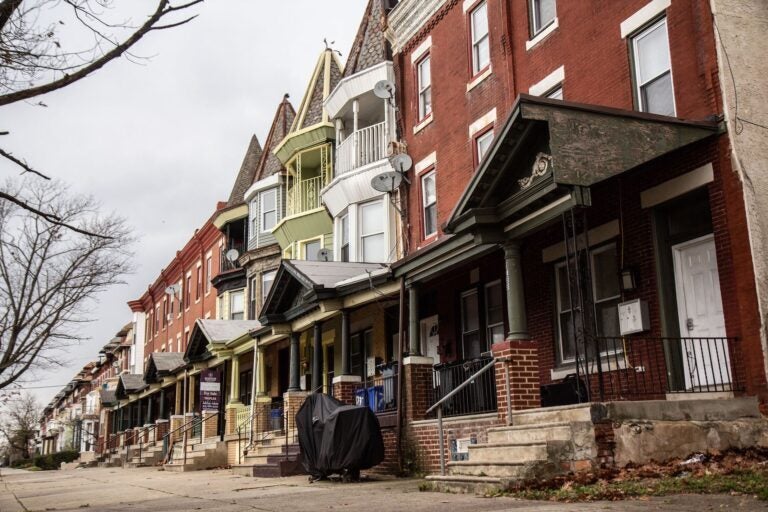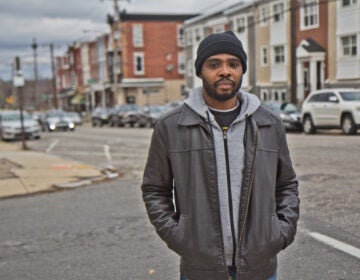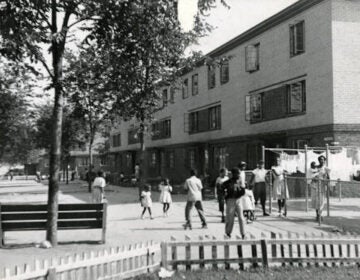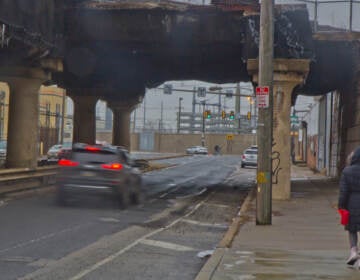The rise of the ‘overlay’: How an obscure zoning tool is shaping Philly’s future (again)
In a year when many land use matters were disrupted by the pandemic, City Council created six new neighborhood overlays aimed at shaping development.
Listen 1:44
Homes across from Fairmount Park at 33rd and Clifford streets included in a new Strawberry Mansion Neighborhood Conservation Overlay District. (Kimberly Paynter/WHYY) (Kimberly Paynter/WHYY)
These days, everyone wants to talk to Tonetta Graham about overlays — a zoning tool that can be used to shape development in a specific area.
What would normally pass for municipal minutiae is a hot topic because Graham’s Strawberry Mansion Community Development Corporation and a coalition of other neighborhood groups recently won City Council approval for a special overlay district that aims to slow gentrification by restricting the height and density of new construction. Graham and her colleagues proposed the “Strawberry Mansion Neighborhood Conservation Overlay District” late last year after watching blocks of brick rowhouses begin to change with construction that they felt clashed with the historic fabric of the community. Roof decks are banned in the new district, along with certain popular facade wrappers such as vinyl, stucco and horizontal aluminum.
“We’re just trying to keep some sense of the neighborhood that we know,” said Graham, president of the Strawberry Mansion CDC.
Now, other community groups from across the city want to know how they too can use the overlay tool.
“I’ve got lots of neighborhood groups asking about it. My phone has been ringing off the hook,” she said.
For groups like Graham, the new district represented a big victory — and one she says could easily be replicated in other gentrifying sections of Philadelphia.
More affluent neighborhoods have used similar tools for decades — just a few months prior, residents in the affluent Society Hill neighborhood secured another overlay limiting the height of development in some areas and reducing density bonuses for historic projects. But the Strawberry Mansion conservation overlay marked the first use of the tool in a working-class, Black neighborhood, establishing preservation standards much like those used in wealthier, often whiter areas and giving residents more control over change in their community.
“If other communities knew this, maybe they wouldn’t feel so powerless,” Graham said.
Nine years ago, overlay had become something of a dirty word in Philadelphia, following a years-long zoning code reform process that sought to simplify the city’s development rules. Now these bespoke zoning districts are back in a big way. In 2020, a year when many land use matters were disrupted by a pandemic, City Council created six new overlays aimed at molding development. Some covered whole neighborhoods, others single blocks; some curbed development, others encouraged it. Others already on the books can stipulate environmental, advertising, or noise pollution controls.
If the return of the overlay feels like a sign of rightful neighborhood empowerment to advocates, critics who support less restrictive approaches to development fear the trend, unchecked, could have wide-reaching consequences such as making it harder to build affordable housing. They say that the city is now inching closer to eclipsing the number of special zoning districts prior to the 2012 zoning code overhaul that eliminated or consolidated many such districts as a reform and fear the slow, patchwork death of a regulatory framework that aimed to encourage a more predictable zoning code and ideally, a more walkable, transit-oriented and populous city.
“It’s very concerning,” said Ben She, from the urbanist advocacy group 5th Square, which generally supports more liberal zoning laws. “It speaks to how politicized the zoning code process is, even after the 2012 zoning code rewrite.”
The draw of hyperlocal control
The newest districts vary in scope and impact. The Wynnefield Overlay District passed in December and effectively banned small convenience stores from parts of that neighborhood. Another overlay allowed more density around the American Street corridor in Kensington — in exchange for affordable housing requirements. Two other tiny overlays in West Philadelphia effectively rezoned single parcels ahead of specific development projects.
Emily Hamilton, a research fellow at the Mercatus Center who studies land use, said that Philly was unusual in its use of bespoke zoning districts. She attributed the difference to the unusual weight given to local councilmembers in the zoning and development process –- sometimes known as councilmanic prerogative.
“Cities that have strong councilmanic or aldermanic traditions tend to be less developer-friendly and more deferential to neighbors near where change or redevelopment is occurring. That’s usually over a more planner-driven approach,” she said.
Of course, it was not uncommon to see pushback against development or gentrification in other cities, Hamilton said. But typically historic districts or blanket downzoning were more common tools to address similar neighborhood concerns in other cities.
However, in Philadelphia, proposed historic districts have often become centers of controversy — eliciting fear from residents about possible consequences including gentrification, a loss of development opportunities and increased home maintenance costs linked to historic status.
Graham said that’s one reason why her group opted for a conservation district, which controls what new development looks like without enforcing historic design standards on existing homeowners.
“Historic districts limit residents in terms of what they can do with home repairs,” Graham said.
Cities like New York, meanwhile, have seen neighbors and city planners agree to more large-scale rezoning in response to gentrification fears. These efforts have seen large residential areas zoned to be less dense usually while increasing density around transit stops, major arteries or waterfront areas as a tradeoff to planners looking to accommodate more growth.
These efforts are certainly not without controversy. But in Philadelphia, remapping efforts have also proven to be nonstarters for large swaths of the city, with some councilmembers leery of relinquishing control over future development.
Graham also said her neighborhood had mainly opted for a new overlay over rezoning because none of the city’s existing base zoning categories seemed to fit.
“The by-right options in the new zoning code, when it was established, it was great. It eased all of these variance processes,’’ she said. “But they found a residential design that worked in certain neighborhoods and then they wanted to translate to every neighborhood.”
Across the city, these attitudes are increasingly being articulated through similar themes of neighborhood preservation. From Society Hill to Strawberry Mansion, advocates for tighter zoning controls present themselves as preserving what they already like about their neighborhood.
“It cuts across race and class. And it’s something that divides self-described urbanists: whether there is a right to defend neighborhood character,” said Matt Ruben, former head of the Northern Liberties Neighborhood Association. “Many people want to support their neighborhood character.”
Ruben, who participated in the zoning reform process, said overlays used to be more pervasive. During a year-long engagement process, the patchwork of overlays had become a symbol of dysfunction for a zoning code critiqued as so outdated and capricious that even uncontroversial new development often required a variance.
“The motivation to update the code was that there was too much development that was not by right,” said Ruben. “And there was an attempt by the Philadelphia Planning Commission to eliminate and streamline as many overlays as they could.”
Through consolidation or abolition, 48 different overlays were reduced to 17 during these reforms. Still today it is not hard to find head-scratching exceptions, particularly in the sprawling overlays like Center City, which contains upwards of 50 different sub-districts spanning multiple neighborhoods. Check cashing stores, tattoo parlors, adult bookstores and takeout restaurants, for example, might be banned or restricted in one downtown control area but allowed in another just a stone’s throw away.
In areas like Northeast Philadelphia, grappling with neighborhood change or economic decline, explicitly exclusionary overlays also emerged in the wake of the more liberal 2012 code. A historically white, middle-class area that has become more diverse over the past two decades while average income has dropped, saw district Councilmembers Brian O’Neill and Bobby Henon introduced bans on hookah lounges, roof decks and doctors offices –– an end run to block the opening of new methadone clinics.
Ruben — whose Northern Liberties neighborhood itself long ago passed an overlay to block nuisance nightclubs along Delaware Avenue — said while some responses were intentionally meant to be exclusionary, others emerge after neighbors were simply fed up with a lack of enforcement from city’s regulatory departments.
“They’re using the zoning code to solve problems that could maybe be solved by city agencies,” he said.
This past December, City Council approved a significant expansion to the Wynnefield Overlay District, on the western edge of the city. While the overlay was technically created in 2019, it was initially conceived only to block the opening of a marijuana dispensary proposed for the area and opposed by residents. The recent additions expanded restrictions to block any new convenience stores or drug paraphernalia sellers from opening anywhere in the neighborhood.
Wynnefield Residents Association President Crystal Morris said a string of corner stores had recently proliferated along the neighborhood’s commercial strip, a trend she linked to general neighborhood decline. She tied the new stores to nuisance violations –– exceeding legal operating hours, selling tobacco or unlicensed goods near a school and attracting crime.
“We have a high population of seniors who are afraid to go to the commercial corridor,” she said. “They’ve had their purses snatched.”
Earlier attempts to zone out such stores or use the city’s Department of Licenses & Inspections to crack down on business owners proved fruitless, she said. While Morris concedes the overlay won’t address neighbors’ current issues, she said the association believed it would prevent them from getting worse.
“We can’t fight them on zoning. We’re not getting any support from L&I in making sure they’re compliant. So who do you point the finger at?” she said. “It’s about oversaturation. And overlays work, they’re helpful tools.”
But other overlays are not necessarily about blunting the scope of development. An overlay along the city’s waterfront has long promoted density, and some scattered transit-oriented development districts have aimed for the same near SEPTA stations.
Councilmember Jamie Gauthier supported the Haverford Village Overlay District last year, which advances a particular mixed-use development, for yet another reason: speed. Her office said the project was dependent on funding that would help construct affordable housing units.
“We pursued the legislative route for this zoning to ensure that the funding and permit review schedule for the affordable housing component was not put in jeopardy, which could in turn create hurdles for the entire mixed-use development,” said Gauthier spokesperson Stephanie Browne.
Fears of a two-tiered system
The coming year will likely see more battles over new zoning districts that are similarly aiming to spark more development in certain areas. Councilmember María Quiñones-Sánchez said she plans to push again to pair affordability and density, pointing to an inclusionary zoning overlay bill she enacted last fall, which authorized denser mixed-use development around American Street with a 20% affordability requirement, as one example.
“The district will help create mixed-income neighborhoods,” she said. “I’m going to get 200 units of affordable housing without spending a dime.”
These proposals were a source of contention. A companion bill that would have cleared the way for a luxury condo project was assailed while neighbors said the broader legislative package would accelerate gentrification, imperil community gardens and produce “affordable” units that many existing residents could not actually afford.
“You need to start worrying about the people who live in this neighborhood, not the people who come from out of town to live in the neighborhood because it’s the hot spot to be in,” Anthony Patrick, a lifelong neighborhood resident, said at a Planning Commission hearing on the proposal in June.
Still, the American Street Overlay passed into law and Quiñones-Sánchez said she’s interested in expanding similar zoning requirements elsewhere as a route to increase the supply of affordable housing. But these would also likely manifest as smaller overlay districts due to likely opposition to a citywide inclusionary zoning bill that offers increased density in exchange for affordability requirements.
Quiñones-Sánchez said she hopes the American Street district could become a successful pilot to demonstrate affordability and density can coexist without destroying neighborhood character.
“We’re really a city of neighborhoods. And changing that neighborhood-to-neighborhood flavor has to be done in a certain way,” she said. “When you have blunt instruments, you have to demonstrate that they can work. And right now people in Philadelphia just don’t believe it.”
Although the Strawberry Mansion overlay was nominally a response to gentrification fears, that district explicitly blocked the kinds of density bonuses that inclusionary zoning policies use to coax affordable housing out of private developers.
Graham explained groups like hers were skeptical about these types of zoning categories, associating multi-family housing with transient residents, neglectful landlords and other nuisances.
“The trash is the number one complaint. You see once these units are up, you see more trash,” she said. “The number two issue is parking, but we understand that’s all around the city.”
She also said that neighborhoods like Strawberry Mansion felt they had born a disproportionate brunt of past affordable housing initiatives aimed at creating affordable rental units.
“We have over 200 units of PHA housing and more to come. And we’ve had a lot of other affordable housing,” she said. “So we’re not lacking for affordable housing, even though we always need more. But we want to see affordable homeownership.”
To zoning liberalization proponents like Hamilton, these were the downsides of turning over major aspects of zoning control to neighborhood groups. In many areas, both in Philadelphia and elsewhere, apartment buildings often bore the brunt of neighbors’ ire, even though exclusively promoting single-family housing can also exacerbate the impacts of gentrification.
“If you restrict to single-family housing only, you’ll see a pattern of new single-family homes or existing houses being renovated and flipped,” she said. “And the new or flipped single-family housing is going to be much more expensive than apartments would have been.”
Hamilton also said that relying on neighborhood zoning districts would increasingly create a two-tiered dynamic, where housing demand was catalyzed into other areas with fewer controls.
“Rules that make gradual change feasible help prevent the rapid-fire gentrification seen when development is pushed into a few areas,” she said. “Making more development feasible in, say, Center City would help take gentrification pressure off of bordering areas.”
Ruben was supportive of the zoning reform process a decade ago, but also long represented a neighborhood that heavily gentrified over the past 30 years. He said fears that deregulation would lead to out-of-control development were hardly baseless. Waving away these fears with supply-side economics was missing the point — that many existing residents feel their neighborhoods are slipping out of their control.
“The urbanists will say you’re artificially restricting housing supply and keeping people out by opposing large or dense new development. But existing residents will often say ‘Why does a rowhouse neighborhood have to be turned into a different kind of neighborhood?’” Ruben said.
This spring, these questions will likely play out in public as the Philadelphia Planning Commission moves forward with an update of the citywide master plan that guided the zoning changes made in 2012. The city’s goal this time is to bring more Black and brown residents into the process so that the plan better reflects community desires, said Eleanor Sharpe, the executive director of the City Planning Commission.
Graham saw few problems with her neighborhood’s experiences using an overlay, regardless of its broader impacts, and that the local groups she worked with were pleased with the outcome. But she said the experience also revealed a need for more planning work to be done at the neighborhood level.
“We’re not against development,” she said. “But this highlights the need for something to change. That something is wrong if this is the route neighbors have to go to preserve their neighborhood.”

Subscribe to PlanPhilly
WHYY is your source for fact-based, in-depth journalism and information. As a nonprofit organization, we rely on financial support from readers like you. Please give today.











